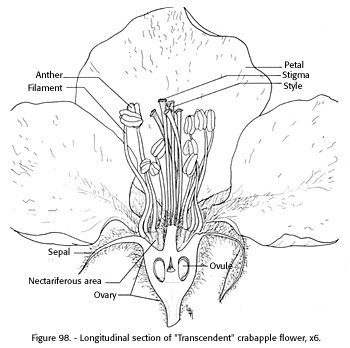CRABAPPLE
Malus spp., family RosaceaeA crabapple is basically a small apple. Hedrick (1938*) concluded that the most common crabapples are hybrids of the common apple and the Siberian crabapple (Malus sylvestris Mill. x M. baccata (L.) Borkh. He listed and described 23 cultivars, and Bailey (1949*) listed eight species. Jefferson (1966) stated that there were more than 200 species and cultivars in the National Arboretum. Wyman (1965) stated that there were 250 cultivars in the Arnold Arboretum. The USDA (1967) listed 19 popular cultivars including six hybrids. Van Dersal (1938) listed 10 species of crabapples of value in erosion control and of value to wildlife.
The crabapple fruit is not an important crop. The plants are grown primarily as ornamentals, although a few growers produce the fruit commercially. The fruit is preserved or pickled or it is used in making jellies. No production data are available on the quantity of fruit that is used commercially.

Plant:
Most crabapples are grown for their ornamental value, and cultivars are chosen because of their beautiful flowers, foliage, or fruit. The general appearance is similar to a small bearing apple tree. Culture is also similar to the culture of apple trees.
Inflorescence:
The flower is similar to that of the apple. Nectar secretion and pollen production has not been studied in detail. Bees freely visit the flowers, for both nectar and pollen (fig. 98).
Pollination Requirements:
Like the apple, the crabapple appears to require cross-pollination between cultivars by insects. Bradford and Bradford (1949) and Crandall (1928) concluded that all native crabapples are self-sterile. Pammell (1920) stated that self-pollination is impossible and that pollinating insects are absolutely needed. Cook (1891) covered 200 blossoms, which set no fruit, the same number not covered set three fruits. Jefferson (1968) discussed a new crabapple cultivar called "Fugi" whose anthers are generally sterile.
Pollinators:
Little is known about which insect pollinators are of most value to crabapples. Pammel and King (p. 239, 1930*) noted that the often cultivated Iowa wild crabapple was freely visited by honey bees. Considering that the only difference between the crabapple and the apple is fruit size, the deduction would appear reasonable that the most effective pollinator of apples, the honey bee, should be equally effective on the crabapple. Although the evidence is meager, it indicates that pollinating insects are essential for crabapple fruit production.
Pollination Recommendations and Practices:
Individual or dooryard plantings usually are likely to receive ample insect pollination. If commercial fruit production is anticipated, and crabapple trees are grown along with other fruit trees in commercial orchards, there is a likelihood that additional pollinating insects will be required. If the grower is providing bees for his other fruits, then he should provide enough for crabapples also.
[gfx]
FIGURE 98. - Longitudinal section of 'Transcendent' crabapple flower, x 6.LITERATURE CITED:
BRADFORD, E. C., and BRADFORD, R. H.
1949. POLLINATION OF NATIVE CRAB APPLES OF THE NORTHEASTERN UNITED STATES. Amer. Soc. Hort. Sci. Proc. 54: 133-136.COOK. A. J.
1891. BEES AS FERTILIZERS. Mich. State Bd. Agr. Ann. Rpt., p. 147.CRANDALL, C. S.
1928. NATIVE CRABS: THEIR BEHAVIOR IN BREEDING. Ill. Agr. Expt. Sta. Bul. 275, pp. 535 - 560.DERSAL, W. R. VAN.
1938. NATIVE WOODY PLANTS OF THE U.S., THEIR EROSION-CONTROL AND WILDLIFE VALUES. U.S. Dept. Agr. Misc. Pub. 303, 362 pp.JEFFERSON, R. M.
1966. CRABAPPLES AT THE NATIONAL ARBORETUM. Amer. Hort. Mag. 45: 231-236.____ 1968. FUJI - A NEW CRABAPPLE - AND OTHER DOUBLES. Amer. Hort. Mag. 47: 22 - 25.
PAMMEL, L. H.
1919. A FEW HONEY PLANTS OF THE ROSE FAMILY. In lowa State Apiarist Rpt. 1919, pp. 56-69.UNITED STATES DEPARTMENT OF AGRICULTURE.
1967. GROWING FLOWERING CRABAPPLES. U.S. Dept. Agr. Home and Gard. Bul. 135, 8 pp. WYMAN, D. 1965. TREES FOR AMERICAN GARDENS. 502 pp. The Macmillan Co., New York.
